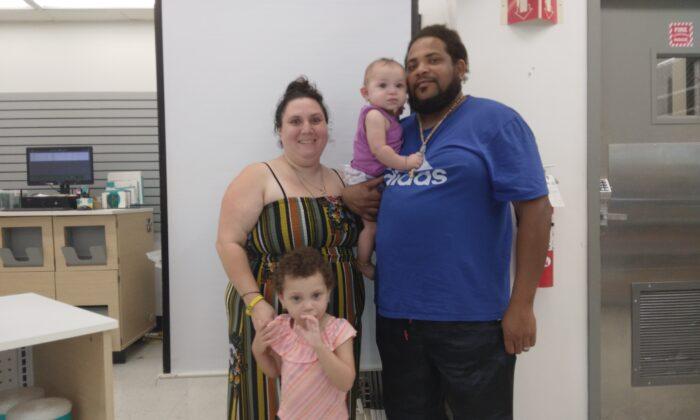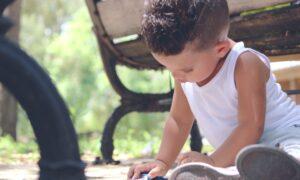When Jaimie Rose and her husband Ryan found out they were expecting their second child in January of 2020, they decided to move from Georgia to Florida. Then, before the first trimester was over, COVID hit.
“I started to panic,” Jaimie, 33, remembers. “How are we going to have a birth in the hospital?”
The Roses had no family in Florida and a two-year-old with developmental delays. Pandemic-imposed hospital restrictions combined with a bad birthing experience in the hospital with her second born (Jaimie also has an older daughter from a previous relationship) led the Roses to explore the option of out-of-hospital birth. Through their spiritual community they found a midwife they liked and trusted and a doula to assist them. They decided to have the baby at a freestanding birth center, Palms Birth House, in Delray Beach, in a home-like setting.
A Drained Battery With No Charger In Sight
Jaimie says she was excited to have an out of hospital birth. But she was also nervous. The whole proposition “felt a little scary,” she explains. Things happened quickly: Jaimie’s water broke at 2:00 a.m. at the hotel and she was already five or six centimeters dilated when she, Ryan, and Armani got to the Palms Birth House.The midwife they had hired, Mirlande “Mimi” Casseus, rented space from the Palms. Casseus, two assistants, and a doula met the Roses there. At a 36-week ultrasound the baby was head down. But when Casseus examined Jaimie, who was in active labor, she realized the baby was presenting buttocks first.
But the labor wasn’t easy. Jaimie had planned to labor in the birthing pool but the minute she got in the water she felt so uncomfortable she asked her birth team to help her out. She was encouraged to try sitting on the toilet or the birthing stool during contractions, but that felt excruciating too. In fact, Jaimie says, the only position that wasn’t unbearable was when she was flat on her back with her legs up, a position favored by hospital obstetricians but one that makes it harder to deliver since gravity is working against you.
It was exhausting. “I was like a drained battery with no charger in sight,” Jaimie says. “When the baby’s butt down it’s like trying to push out mush!”
Doctors Don’t Know How to Deliver Breech Babies
A breech baby is a baby whose bottom half—rump, foot, or feet—engages in the birth canal and emerges first. Though most babies move to a head-down position before labor begins, and some will even turn head down during labor, about 3 to 4 percent of babies will be breech at term.In other words, parents whose babies are presenting breech and want to deliver vaginally may have a hard time finding a doctor with the requisite experience.
That, says Stuart Fischbein, M.D., a member of ACOG and an obstetrician with 35 years of experience, is the real problem. Fischbein, who is based in Southern California, has delivered over two hundred breech babies vaginally.
Kristine Lauria, a midwife based in Michigan, agrees. Lauria works for Doctors Without Borders, going to some of the world’s most remote places to provide care for women of childbearing age. She specializes in non-medicated, out-of-hospital breech birth: She has 32 years of experience and has delivered nearly 5,500 babies, 473 of which were born breech.
“Everybody has the right to choose where they want to have their baby, but the hospitals don’t see it that way,” Lauria says. “Then, when pregnant women go outside the hospital system—because the hospital didn’t give them a choice—they’re penalized and discriminated against.”
Exhilarated, But Not For Long
“I did it!” Jaimie cried triumphantly the moment her daughter was born. But her exhilaration was short-lived. Ariana Stella was gray-blue, limp, and silent. The midwife took the newborn to resuscitate her. She pinked up and was breathing on her own soon after. But Jaimie felt like Ariana was too quiet, especially compared to her two other newborns. And she noticed that her baby’s upper lip and forehead looked discolored.It was a decision, Jaimie says, she will regret for the rest of her life.
Jaimie wasn’t planning to nurse and the baby hadn’t yet taken a bottle. Jaimie begged the nurses to let her hold her baby or at least stay by her side. But not long after they got to the hospital, Jaimie and Ariana were separated. The nurses told Jaimie that Ariana needed to stay under the warming lights and would be transferred to the NICU when a space opened up. Jaimie was taken upstairs in a wheelchair. She would not see her baby in person or hold her again for over five months.
Jaimie remembers the nurses talking to each other in a corner of the room and turning to look at her. And then the hospital called the Florida Department of Children and Families.
Court documents reveal that the hospital staff believed Ariana had been abused. They noticed bruising on one of Ariana’s buttocks and on one labia, a normal occurrence during breech birth.
A detective and two case workers from DCF crowded into Jaimie’s hospital room. Jaimie says that Kara Faso, senior child protective investigator, informed her—several times—that someone had hurt the baby.
Documents reveal that DCF believed the couple may have burned their newborn on a hotplate and sexually assaulted her.
Medical Discrimination?
Even though she was in a lot of pain and couldn’t go to the bathroom without assistance, Jaimie was told she looked “too good” to have just had a baby.At the same time, another investigator, identified as “CPI Gedeon” in the records, went to the hotel where Ryan was taking care of Armani. The investigator found no signs of physical abuse on Armani. He asked Ryan to submit to a drug test. Ryan readily agreed. The test came back negative. But DCF called the police, told Ryan to pack some things for Armani, and took her into state custody.
Medical Records: No Indication of Abuse
As Lauria pointed out in a deposition for the attorneys for DCF, the hospital’s own medical records show no indication of abuse. After examining Ariana, the hospital’s plastic surgeon, Dr. Avraham Schlager, M.D., wrote, “Labial edema (swelling) and bruising, no lacerations seen … buttocks without lacerations or bleeding, appears as if these are pressure induced’ …‘Plan: No lacerations seen, apply bacitracin to the buttocks exposed skin. This is likely due to trauma from the birth canal.”Both Girls Taken Into Custody
Born on October 7, Ariana was kept in the hospital for eleven days. On October 8 Armani was taken into custody and placed in foster care. The two girls were allowed video visits with their parents but no in-person visits.In the time they were separated from their parents the girls went to three different foster homes. Armani’s beloved stuffed animal, Frog Man, was lost. When she finally got Frog Man back he was covered in urine. Jaimie has no idea why.
“Basically, this family was punished for giving birth,” says Lauria, who personally reviewed over a thousand pages of medical and court records, including photos of the newborn. “Most of the child welfare report is fictitious and ridiculous. I’ve never seen anything like it.”
Ryan is a truck driver. Jaimie was a stay-at-home mom. Desperate to get their daughters back and making no headway with their state-appointed lawyer, in early March of 2021 the Roses hired a private attorney and found two health professionals, Lauria and David Hayes, M.D., co-founder of Breech Without Borders. Both were so appalled by the facts of the case that they volunteered to testify for no compensation.
Then, on March 10, 2021, after Lauria submitted a draft deposition, DCF filed a voluntary dismissal of the charges against the Roses, canceled the trial, and submitted an order to the judge to immediately release Armani and Ariana back into their parents’ care.
With that DCF decision, the Roses were cleared of all wrongdoing. But they have never received an apology or any kind of explanation from either Florida’s Department of Children and Families or St. Mary’s Medical Center.
DCF ignored repeated telephone and email requests for an interview. “Information regarding child protective investigations is confidential per Section 39.202, Florida Statutes,” Paige Patterson-Hughes, Southeast Region Communications Director for DCF Southeast Region, wrote in an email.
St. Mary’s Medical Center also refused to be interviewed. “We are committed to providing high quality care in an environment that safeguards and advocates for the tiniest of patients,” Public Relations Manager Ryan Lieber wrote in a written statement.
“Due to patient privacy requirements, we can’t comment on any specific case. It is important to note that healthcare providers are mandatory reporters. We are required by Florida state law to report to the Department of Children and Family Services any instance where we have a good faith suspicion that a child may have been abused or neglected. We take our legal and ethical obligations seriously and fulfill them thoughtfully.”
But Lauria believes the hospital staff acted unethically. “This was a travesty and a massive overreach by hospital authorities and DCF in my opinion,” she argues, adding that it was the hospital staff and the child welfare workers’ general ignorance about breech birth and deep bias against parents who choose out of hospital birth that led to the traumatic way the Roses and their daughters were treated.
Marlene Waechter, a homebirth midwife based in Jackson, Ohio who was not involved in the case, points out that bruising is expected when a baby is born breech, but it doesn’t last long and it’s easily treated.
“Putting arnica gel on whatever soft part comes first prevents most of the bruising, and reduces swelling quickly,” Waechter says. “It works even on hematoma (broken blood vessels under the skin from the pressure of birth) and caput (the swelling on the head when it takes a long time to crown), as well as butts, balls, and feet.” With proper care the bruising, Waechter says, will clear up in less than a week.
Armani Stella, 3 years old now, is just starting to say some words. She loves watching Family Feud, splashing water in the bathroom sink, and riding in her father’s semi.
Ariana Nova, 9 months old, is teaching herself to crawl. She gets on all fours, butt in the air, and rocks back and forth. She babbles non-stop and has two teeth.
The family has only been reunited for four months. They’re working hard to get to know each other again. Every day is a struggle. Armani has nightmares so terrifying that she wakes up screaming. Ariana cries hysterically if her mom is out of sight, even for just a minute. Armani does too.









Friends Read Free